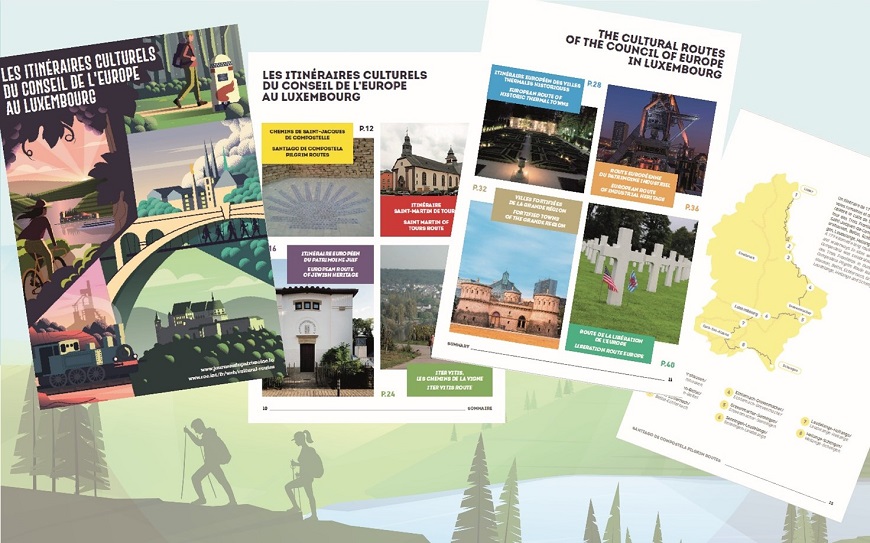Background: ©VVadi4ka/shutterstock
Since 1991, the Council of Europe has been organising the European Heritage Days (EHD) with the assistance of the European Union. This year’s theme, ‘Routes, Networks and Connections’, serves as a unique opportunity to explore the interconnections of cultural heritage across Europe, particularly through the Cultural Routes of the Council of Europe.
Luxembourg, as one of the 41 member States of the Enlarged Partial Agreement on the Cultural Routes (EPA), is home to 8 of the 48 recognized Routes, each representing diverse themes that reflect European memory, history, and heritage.
In an effort to align the theme of the European Heritage Days 2024 with the Cultural Routes of the Council of Europe programme, the ministry of Culture of the Grand Duchy of Luxembourg, in collaboration with the European Institute of Cultural Routes based in Luxembourg, is publishing a brochure to mark the occasion. This publication showcases the 8 Cultural Routes of the Council of Europe that traverse Luxembourg, aiming to encourage visitors to explore these Routes independently. Designed for use beyond the European Heritage Days 2024, the brochure details the locations and heritage sites associated with each Cultural Route in Luxembourg and includes a fold-out map for navigation. The majority of the featured sites are significant highlights of the Cultural Routes and can serve as starting points for further discovery.
Thus, the brochure functions both as a practical resource and an invitation to delve deeper into the Cultural Routes of the Council of Europe and the broader European cultural heritage found in Luxembourg and beyond:
Santiago de Compostela Pilgrim Routes, certified in 1987
On 23 October 1987, the ‘Santiago de Compostela Pilgrim Routes’ was certified as the first ‘Cultural Route of the Council of Europe’. Following the discovery of the supposed tomb of Saint James in northern Spain in the 9th century, the Pilgrim’s Way to Santiago became one of the most important Christian pilgrimage routes. Pilgrims from northern Europe passed through Luxembourg on their way to Santiago de Compostela, following a 179-kilometre route along ancient Roman roads and waterways to sites where the cult of Saint James was celebrated.
European Route of Jewish Heritage, certified in 2004
The European Route of Jewish Heritage highlights the heritage of the Jewish population, which is an indisputable part of European civilisation and history. Jewish presence in Luxembourg is first mentioned in 13th-century documents. Today, Luxembourg is home to the headquarters of the European Association for the Preservation and Promotion of Jewish Culture and Heritage (AEPJ).
Saint Martin of Tours Route, certified in 2005
Known for the emblematic scene of Saint Martin sharing his cloak with a beggar at the gateway to Amiens in the 4th century, Saint Martin of Tours has left a significant mark of humanity and charity on Europe’s collective memory. In Luxembourg, along the Roman road taken by Saint Martin on his way back from Trier, numerous churches, chapels and places of worship have been dedicated to him.
Iter Vitis Route, certified in 2009
Since the domestication of the vine several thousand years ago, wine-growing activities and landscapes have shaped many areas and customs throughout Europe. The ‘Iter Vitis’ Cultural Route brings together wine-growing regions in more than 20 countries. In Luxembourg, Iter Vitis runs along the Moselle River for 39 kilometres, passing through picturesque villages surrounded by vineyards in a unique cultural and river landscape.
European Route of Historic Thermal Towns, certified in 2010
The therapeutic use of hot springs has marked Europe from Antiquity to the present day. As witnesses to the development of new medical treatments in the 18th and 19th centuries and with a rich historical heritage across Europe, more than 50 spa destinations are part of the European Route of Historical Spa Towns. With thermal springs used for therapeutic purposes since 1847, the town of Mondorf-les-Bains is the only town in Luxembourg to be included in the Route.
Fortified Towns of the Grande Region, certified in 2016
The Route of the Fortified Towns of the Grande Region brings together a rich architectural heritage of fortresses. Today, this transnational area between France, Germany, Belgium and Luxembourg, known as the ‘Grande Région’, has become a remarkable model of peace, cooperation and economic and cultural exchange. Thanks to its strategic position, the fortress of the City of Luxembourg was one of the most important fortified sites in Europe from the 16th to the 19th century. The old quarters and fortifications of Luxembourg City have been on UNESCO’s World Heritage List since 1994.
European Route of Industrial Heritage, certified in 2019
The European Route of Industrial Heritage tells the story of European industrialisation and its cultural, social and economic heritage, scientific discoveries, technological innovation and the lives of workers. In Luxembourg, the Route invites visitors to rediscover the sites of the country’s industrial development, in particular the steel industry, which predominated between the mid-19th and late 20th centuries.
Liberation Route Europe, certified in 2019
The Route of the Liberation of Europe explores the route taken by the Allied forces in 1944-1945 to liberate Western Europe from Nazi occupation. During the Second World War, Luxembourg was occupied by the German army from 1940 until its liberation by the Allied forces in 1944. The Battle of the Bulge continued to rage throughout the winter of 1944/1945, and the country was definitively liberated on 10 May 1945.
The brochure is available for download on the European Heritage Days website of the ministry of Culture (starting from September 26).
This year, Luxembourg’s European Heritage Days calendar includes 11 cultural events that are associated with the themes of 6 out of the 8 Cultural Routes of the Council of Europe in the country. Comprehensive information regarding all events related to the European Heritage Days and the Cultural Routes of the Council of Europe in Luxembourg can be found on the dedicated website of the ministry of Culture.
Source link : https://www.coe.int/en/web/cultural-routes/-/european-heritage-days-2024-new-brochure-on-the-cultural-routes-of-the-council-of-europe-in-luxembourg
Author :
Publish date : 2024-09-24 08:44:20
Copyright for syndicated content belongs to the linked Source.
